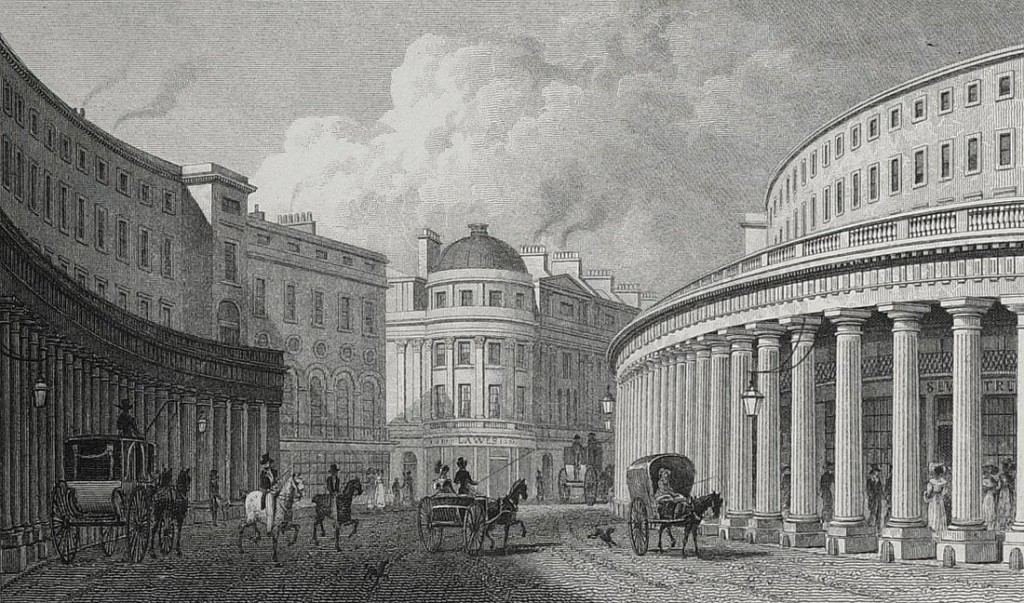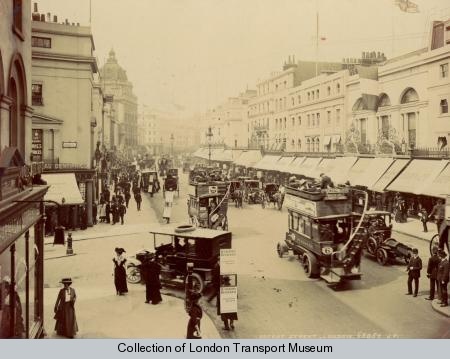An occasional series where I look at something and ponder – what if.
Regent Street in central London, while looking very impressive and of a certain age, is a relatively modern street, with a layout that is just under 200 years old — replacing old slums — and the buildings that line it today are themselves only around 100 years old as well.
When originally laid out in 1825 by John Nash, the buildings were lower than today and the shops often considerably smaller individual units.
However, the most dramatic difference was the curved section as the southern end, which had a stone colonnade running along the pavement to protect shoppers from the worst of the British weather.
While visually dramatic – it was a practical failure. Designed to attract shoppers, it actually ended up deterring them. Shops complained that the heavy roof and thick columns blocked out much of the daylight that was so necessary in these pre-electric lighting days.
And once day had fled and night arrived, the protected walkway made it a magnet for the local ladies of the night from neighbouring Soho and suitably outraged Victorian sensibilities (while also catering to their baser needs).
Following a petition presented to Parliament and signed by the majority of the shops in the Quadrant in September 1846, the colonnade was torn down in 1848 – under the pretext of being structurally unsound.
The cost was not insignificant though and an attempt to sell the iron and stone for scrap in November 1848 didn’t raise as much as had been hoped, as noted in The Morning Post. The granite plinths the columns stood on were also sold separately, and it was reported by the Sussex Advertiser that the main lot was sold to the Eastern Counties Railway Company.
It would be quite nice to think that the lingering remnants of the colonnade columns and plinths still exist somewhere.
The removal of the colonnade may have been welcomed by the retail stores of the time, but not everyone was happy – and The Times newspaper thundered its disapproval of the destruction of the colonnade stating that “it has been laid waste through the mercenary cupidity of a set of barbarians, who from this moment forth are doomed to the destruction in which they have involved.”
“These Sampsons of eigars and ribands have uprooted the pillars of the Quadrant from the solid earth, but upon their own heads the first destruction will fall!”
Stirring stuff.
Also, there is this rather more sombre note from The Builder printed in the Morning Post of September 1848.
Then again, The Era newspaper commented that following the destruction of the Colonnade, “the gambler, and the pickpocket, and the prostitute, will find the place less congenial, and the metropolis has cause to rejoice in the fact.”
However, just 50 years later, the rest of the buildings lining the street – and indeed, the entire of Regent Street was in turn also torn down between 1895 to 1927 and replaced by the modern street we know today. The pretext being the expiry of the original 100 year leases giving the Crown Estate an opportunity to replace the small shops with the much larger ones desired by retailers and the new Department Stores.
However, despite huge advances in gas based street and shop lighting, the colonnade was not replaced – in fact it was explicitly omitted. However, in possibly a great historic irony, the shops all then had to have fabric blinds extending from their shop fronts to protect the displays within and provide some shelter to shoppers.
And here is the point were fantasy architecture comes in – could the colonnade be replaced, and would be desirable to do so?
I think the first thing to note is that the replacement would not have so many columns – which did so much to block out the light originally. Modern materials mean we can get away with a tiny fraction of columns, and those can also be very thin compared to the robust structures of old.
You could actually support the roof from above – but then it would just look like fixed shop blinds and lack the columns that would hold the structure together aesthetically.
So, sticking to the idea of a restoration of the colonnade – probably done sympathetically with the existing buildings. From below you gain a covered walkway and from above, a flat roof to look down on that helps deflect the noise of road and pedestrian traffic below.
The idea could be tested quite easily one winter as well by erecting a temporary scaffold with a watertight roof to see what shops and shoppers think of the idea – and if popular, could be then added to the Quadrant to recreate that original 1825 design.
Maybe in time for the 200th anniversary of Regent Street in 2025?
A very good history of the area that Regent Street carved through is here.











Another reason for getting rid of the colonnades was that during the day, “cutpurses” would hide behind the pillars and cut the strings of the purses of the rich female shoppers
I work as a tour guide at the Theatre Royal Drury Lane, and have been informed by our archivist that he believes the colonnade, or part of it, ended up on the Russell Street side of our theatre?
Regards
Great article thank you .I am giving a talk at The Society for the Protection of ancient buildings about Regent street which will discuss this and related controversial events on November 26 th 2020.
I hope you can attend